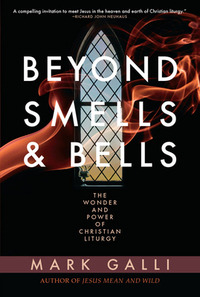Take a photo of a barcode or cover
Succinct and beautiful introduction to Episcopal/Anglican liturgy, what it means, how it preserves God's mystery, and why it's oddness is a good thing.
Although I liked the book, is was disappointed to learn the author is somewhat misleading, in that he implies that he is an Episcopalian. He names his church in the book, so I searched for it online. Upon finding it, I learned that, in fact, he is not an Episcopalian; he is in a church that has left the Episcopal Church USA, only to affiliate with an Anglican archbishop that fits his social and political views.
This is a great, easy to understand book for anyone curious about liturgy or wanting to understand more of what it's about...the symbolism and significance all the parts of it as well as the history in Christian worship behind it.
I grew up in an evangelical environment, so liturgy is largely unfamiliar to me. Yet lately I am craving a little more structure to my spiritual pursuits, a desire for greater understanding of the Christmas holidays in an effort to teach my daughter the meaning behind our traditions. We don't celebrate Advent. (In fact, though I grew up Pentecostal, I've never attended a church that celebrated the Day of Pentecost. Figure that one out!)
I'm coming to see that when we look beyond our fear of idolatry (that many Protestants carry), there is a great richness to some of the traditions of the Church. Every church has a liturgy. Beyond baptism and communion, beyond smells and bells, there are many things that can make my understanding of Jesus and his sacrifice more tangible--and often they involve a greater use of the five senses.
This book challenged me to find greater ways of connecting with the Jesus I love through the "visible, material signs that lead us to things invisible and spiritual." It was a powerful read that I will likely re-read because I suspect there's a lot I didn't pick up the first time around.
I'm coming to see that when we look beyond our fear of idolatry (that many Protestants carry), there is a great richness to some of the traditions of the Church. Every church has a liturgy. Beyond baptism and communion, beyond smells and bells, there are many things that can make my understanding of Jesus and his sacrifice more tangible--and often they involve a greater use of the five senses.
This book challenged me to find greater ways of connecting with the Jesus I love through the "visible, material signs that lead us to things invisible and spiritual." It was a powerful read that I will likely re-read because I suspect there's a lot I didn't pick up the first time around.
A great intro to liturgy and its relevance to our faith. This book reminds us that liturgy does not have to be dead, stale routine, but an engagement of our minds, souls, hearts, and bodies in worship, which transcends place, time, and even our own flaws and failings. The poetry of the liturgy is something I will continue to meditate on for days to come.
I confess that at first I wasn't sold on this book. The chapter titles were convoluted. Each chapter was quite short (the entire book is just over 100 pages). But by mid-read, I found myself struck more often on each page at something said, or a way of re-framing my understanding of worship and liturgy. This book challenged my faith and how I understand my relationship with God, without making me feel like a loser or alone about getting distracted at church or failing to feel any emotive response (at times) to Sunday worship. This book reminded me that the focus of worship is God and not myself, and yes, I am prone to forget that by thinking about my own feelings and responses at church!
I confess that at first I wasn't sold on this book. The chapter titles were convoluted. Each chapter was quite short (the entire book is just over 100 pages). But by mid-read, I found myself struck more often on each page at something said, or a way of re-framing my understanding of worship and liturgy. This book challenged my faith and how I understand my relationship with God, without making me feel like a loser or alone about getting distracted at church or failing to feel any emotive response (at times) to Sunday worship. This book reminded me that the focus of worship is God and not myself, and yes, I am prone to forget that by thinking about my own feelings and responses at church!
It would have been five stars if there weren't so many sports metaphors, although I am aware that could be an attraction for another reader. Otherwise I really appreciated Galli's view of the liturgy.
Well-written book about the why’s and how’s of liturgy and the pivotal, beautiful, and meaningful role it plays in the church. Highly recommend for anyone who’s ever wondered ‘why do they do that?’ about a liturgical practice, even if you do not attend a typical ‘liturgical’ church. (I put that in quotes because even the most non-denominational church has it’s own liturgy, it is just not usually written down and explicitly acknowledged) Also recommend for those who already attend a church that includes these practices and wants to know more.
Our associate priest recommended this book to me for friends and family asking about my confirmation in the Anglican church. In my previous life directing a worship and arts ministry without much direction to go by I've read several good books commending the practices of the historical church. I'd add this book to the list. Mark Galli writes in accessible, winsome language with an occasional poetic insight. I'm looking forward to sharing this book.


